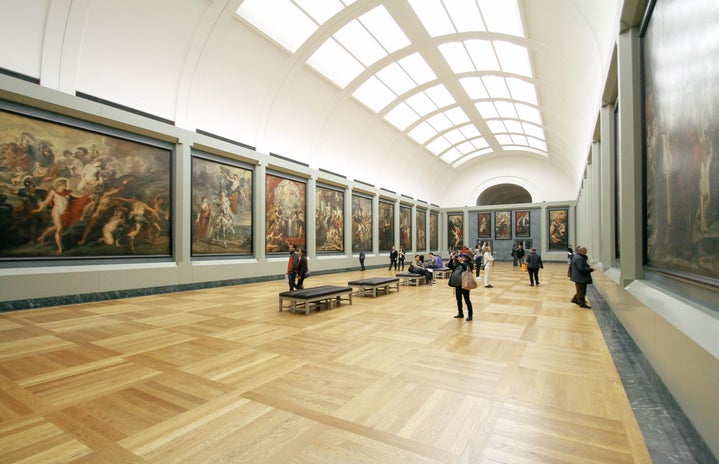Guadelupe Serrano and Alberto Morackis created Border Dynamics, a sculpture of four 14-foot tall figures pushing against a representation of the border wall.
The figures’ flayed skin and the display of muscles and tissues are shocking. It removes the superficial preconceptions of race and reveals the humanity of both sides of the conflict. It forces on the viewer the harsh experience and vulnerability of those involved.
Photo credit: Picssr
3,087 migrant deaths have been documented along the Arizona border with Mexico between 1999 and 2016. These deaths can be visualized by “death maps” that Humane Borders, a volunteer organization, maintains on its website (https://humaneborders.org/migrant-death-mapping/). The maps show the areas where bodies appeared alongside data about age, sex, and race of the deceased.
Photo credit: Humane Borders Website
UA’s public art exhibit Border Dynamics was designed to generate dialogue about the U.S.-Mexico border and social justice issues affecting migrants.
Artists living on both sides of the border have often been drawn to depict their impression of the boundary wall and its influence. The tensions, fear, and deaths it causes has moved many to creates murals and sculptures illustrating the border environment and its consequences.
Olivia Miller, the curator of exhibitions at UA, appreciates the fact that there are multiple ways to interpret the sculpture and that it is not just limited to U.S. borders.
“It [Border Dynamics] is done with enough abstraction that it can represent much more than just the U.S.- Mexico Border. There is nothing about the figures that say they are American or Mexican; this could represent the Berlin wall, the wall in Gaza, it has a lot to do with borders all around the world,” Miller said.
The work encapsulates the complexities of the border and the reality of those living alongside the wall.
“You can’t tell who is right or wrong, which side is pushing the wall back and which side is pushing to get in. I think it shows that there are no easy answers to this situation,” Miller said.
Miller is adamant that the discussion be ongoing and both sides should be heard out.
Border Links facilitates fair and transparent discussion. The non-profit organization based in Tucson, Arizona provides experiential learning opportunities for volunteers and groups to understand the migrant journey and become better equipped to stand up for social justice.
Brian Best, the executive director of Border Links, witnesses first-hand how lives of migrants are affected by the U.S. border and policies.
Photo credit: Border Links Website
“What we try to do is give voice to the people and communities directly affected by migration issues and bring them into the debate. These are often people who are left out of the debate and the mainstream narrative about migration justice issues,” Best said.
Many of the Border Links volunteers walk the trails migrants use to cross the border to get a better idea of what it is like to make that journey. They will leave food and water along the desert routes to prevent deaths.
Photo credit: Border Links Website
Groups of volunteers spend time visiting with migrants in detention centers in Florence, Arizona as well as observing court proceedings and Operation Streamline.
“Operation Streamline is the U.S. government’s fast-track court proceeding for migrants detained by the Border Patrol. In the course of a 2-3 hour hearing every afternoon at the federal courthouse in Tucson, approximately 70 migrants are sentenced to a term of detention followed by immediate deportation,” Best said.
The U.S. policy of prevention through deterrence promotes the idea of making crossing so dangerous for migrants that word would get back to the communities where people leave that it would be foolish to make the journey.
One of the ways this idea manifested was the building of the wall which began in the 1990’s under President Bill Clinton.
“Since the construction of the wall began over 7,000 bodies have been found in the U.S. along the border between the Gulf of Mexico and the Pacific Ocean. The U.S. Government policy has killed over 7,000 people since the mid- ‘90’s in an attempt to make the journey so dangerous that people would stop coming,” Best said.
Best explains that over the last five years the dynamic has gotten worst.
“But people still come and what I think U.S. policymakers don’t realize is that the reasons people make the journey are so strong that no physical danger will stop people from trying to make the journey to the U.S.,” Best said.
Border Dynamics itself is no stranger to restrictions and disputes.
Willa Ahlschwede, the program coordinator at the UA’s Museum of Art, explains why the sculpture is at UA.
“It was originally installed on the Mexico side of the border in Nogales. The four figures were installed leaning against the actual border wall. The artists had hoped that they would be on both sides, but at some point during the planning process the U.S. border patrol decided to back out on the agreement to have the figures on the U.S. side,” Ahlschwede said.
Photo credit: Orientalista.hu
The artists hope was that it would tour around the country to different border cities and various universities, but that didn’t end up materializing. But it did come to UA as what was hoped to be the first stop, but ended up being the only stop.
It was installed temporarily outside the student union in 2003 and then moved permanently to its current location outside the Richard P. Harvill building in 2005.
“I think it is really easy to forget here in Tucson, and especially in the campus bubble, that we live so close to the U.S.-Mexico border. I like how it [Border Dynamics] is a reminder of the social, political, and economic reality of life on the border and its effects on a lot of people,” Ahlschwede said.
Cover photo Credit: Picssr

